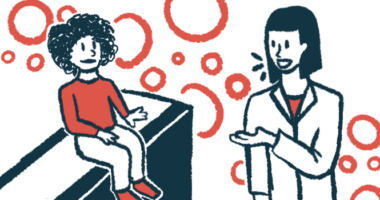Stem cell transplant for sickle cell disease
Last updated Aug. 21, 2024, by Marisa Wexler, MS

What is a stem cell transplant for SCD?
A stem cell transplant — also known as a bone marrow transplant, and more formally referred to as hematopoietic stem cell transplantation (HSCT) — is an invasive procedure that can be used to enable people with sickle cell disease (SCD) to produce healthy red blood cells.
The bone marrow is home to stem cells, known as hematopoietic stem cells, which are responsible for giving rise to new blood cells, including red blood cells and immune cells.
SCD is caused by genetic mutations that lead to the production of an abnormal form of hemoglobin — the protein that red blood cells use to carry oxygen through the bloodstream. The abnormal protein causes red blood cells to become deformed into their hallmark sickle-like shape, leading to a series of complications.
In people with SCD, all hematopoietic stem cells in the bone marrow carry the disease-causing mutation; as a result, whenever these stem cells mature to form new red blood cells, the new blood cells also carry the same disease-causing mutation. The basic idea behind stem cell transplantation for sickle cell disease is to replace a patient’s hematopoietic stem cells with healthy ones lacking the mutation that causes the disease, thereby allowing the production of healthy red blood cells.
When successful, a stem cell transplant can be a cure for SCD. However, the procedure carries substantial risks for severe complications. Therefore, the procedure is generally only recommended for SCD patients in specific situations.
How does the procedure work?
When people talk about a stem cell transplant in SCD, they are usually specifically referring to an allogeneic transplant, which means that the patient’s stem cells are being replaced with healthy stem cells harvested from a donor.
Allogeneic stem cell transplant
The first key step in an allogeneic transplant is to find a suitable donor. In particular, the donor must match the patient with regard to specific markers called human leukocyte antigens, known as HLA, which are found in most cells and help the immune system determine which cells are part of the body and which are not.
Donor stem cells may be collected from bone marrow, blood, or the umbilical cord. Most of the time, an allogeneic stem cell transplant for sickle cell disease uses stem cells collected from a sibling, although matched unrelated donors also may be an option. Once a donor is located, the stem cell transplant can be carried out.
For the transplant itself, a patient first must complete an intensive course of chemotherapy and/or radiation therapy, known as a conditioning regimen. The goal of conditioning is essentially to destroy all or most of the stem cells currently found in a patient’s bone marrow, thus making room for the new, transplanted cells to enter the bone marrow and grow.
The donor cells are then infused into the patient’s bloodstream, making their way into the bone marrow and finally repopulating it. After repopulating the bone marrow, the donor stem cells can then start to differentiate into new healthy blood cells.
Autologous stem cell transplant
In addition to allogeneic transplants that use stem cells from a matched donor, autologous transplants, in which patients are given a transplant of their own hematopoietic stem cells, may be used in some people with sickle cell.
Historically, autologous transplants were considered of little use in SCD because the patient’s own stem cells carry disease-causing mutations. However, in recent years, gene therapies and gene-editing therapies have become available for sickle cell, and these treatments are based on autologous transplantation.
For such sickle cell treatments, a patient’s own stem cells are first collected — a process that involves the use of medications like plerixafor to mobilize stem cells out of the bone marrow and into the bloodstream. That’s followed by apheresis, a method that enables stem cells to be collected from the blood.
Once stem cells are harvested, they are sent to a lab to be genetically modified. The modified cells are then returned to the patient through a procedure that’s similar to that used in allogeneic transplantation: The patient first undergoes conditioning to wipe out the mutated stem cells currently in the bone marrow and then receives the modified stem cells through an infusion.
Potential benefits of stem cell transplant
In the best-case scenario, a stem cell transplant can cure SCD. In other words, patients who undergo a successful hematopoietic stem cell transplantation for sickle cell disease can expect to be mostly or fully free of the disease’s symptoms and related complications.
Sickle cell patients whose stem cell transplant is successful tend to experience a series of long-term benefits, including better survival outcomes and improved quality of life.
Since 1984, when the first allogeneic transplant was performed in a child with SCD, more than 1,000 patients have undergone the procedure, mostly using stem cells from a perfectly matched sibling. More than 90% of these patients were cured for at least five years after the transplant.
The chances of stem cell transplant success depend mainly on two factors: the patient’s age at the time of the procedure, and the type of donor used. As a general rule, the best outcomes are seen in children who receive a stem cell transplant from a sibling who is a perfect HLA match. The likelihood of success is substantially lower for patients who are older, and/or if the donor isn’t a perfect match.
Potential risks and side effects
Although a stem cell transplant has the potential to cure SCD, the procedure carries notable risks of side effects and severe complications. These may be related to the engrafted cells or the medications used to prepare a patient for the stem cell transplant.
Graft versus host disease
One of the most common complications associated with a stem cell transplant is an inflammatory disorder called graft versus host disease (GVHD).
In GVHD, the newly transplanted hematopoietic stem cells mature into healthy blood cells as intended, but the new immune cells recognize the patient’s body as foreign and start attacking it. This can lead to serious organ damage and other medical problems. GVHD can be classified as acute or chronic, depending on the timing and type of symptoms a patient experiences.
Signs and symptoms of acute GVHD, which generally manifests within the first 100 days following transplant, may include:
- skin rash
- diarrhea
- persistent nausea and/or vomiting
- loss of appetite
- signs of liver damage, such as jaundice (yellowing of the skin and eyes).
With chronic GVHD, which generally is seen in the first two years after the transplant, signs and symptoms may include:
- skin rash and itchiness
- hair loss or thinning
- pain and stiffness in the joints
- muscle pain and weakness
- shortness of breath
- irritation in the eyes and mouth
- diarrhea
- persistent nausea and/or vomiting
- abdominal pain.
HLA matching can substantially reduce the risk of GVHD, which is one of the main reasons why donor matching is critical. Yet, even with a perfectly matched sibling donor, GVHD is reported to affect more than 1 in 10 SCD patients who undergo a stem cell transplant.
Graft failure
Another complication that can occur following a stem cell transplant is graft failure. If this occurs, it means the transplant wasn’t successful and the donated stem cells failed to engraft, or take up residence, in the patient’s bone marrow.
The most common reason for graft failure is the patient’s immune system recognizing the donated stem cells as foreign and launching an attack against them. The likelihood of graft failure is higher among patients who aren’t perfectly matched with their donor and in those receiving low-intensity conditioning regimens.
Weakened immune system
To reduce the risk of complications like GVHD and graft failure, SCD patients undergoing a stem cell transplant are typically treated with immune-suppressing medications. Along with the conditioning regimen used before the transplant, this can significantly weaken a person’s immune system.
While immune-suppressing treatments are a necessary part of the procedure, having a weakened immune system means a person’s risk of infection is substantially increased. As a precautionary measure against infections, patients undergoing a stem cell transplant are typically given preventive treatment with medications such as antibiotics and antiviral and antifungal agents.
Infertility
Chemotherapy and radiation therapy, which typically are a part of conditioning regimens, can cause permanent damage to reproductive organs, leading to long-term infertility.
In patients who have gone through puberty, it may be possible to save sperm or egg cells, known as gametes, prior to the procedure. This ensures that, if infertility occurs, the patient may still have the option to have biological children later on should the individual wish to do so.
However, in children who haven’t yet gone through puberty, there’s a high risk of permanent infertility following stem cell transplantation. The likelihood of infertility depends on the specific conditioning regimen used.
Cancer and other long-term health issues
The use of immune-suppressing treatments and toxic conditioning regimens also may increase the risk of several long-term health complications. Such potential health issues include:
- cancer
- heart disease
- lung disease
- kidney damage
- loss of bone mass
- psychological issues, such as anxiety and depression
- metabolic complications, such as diabetes.
Some health complications may develop years after the procedure. Given the increased risk of such problems, patients will typically require long-term monitoring after a stem cell transplant. That way, if any issues arise, they can be identified and addressed in a timely manner.
Are stem cell transplants suitable for everyone?
Even though a stem cell transplant can effectively cure SCD, the procedure is invasive and carries substantial risks, so it is not recommended for everyone with sickle cell. Generally, a stem cell transplant is recommended for SCD patients who have severe disease that isn’t well controlled with medications. These may include those who have:
- experienced a stroke or have abnormal brain blood flow readings
- had recurrent episodes of acute chest syndrome
- experienced recurrent vaso-occlusive crises
- been diagnosed with certain diseases involving the kidneys (nephropathy) or eyes (retinopathy)
- experienced priapism, an unusually prolonged erection, which can occur due to disrupted blood flow.
Importantly, it’s estimated that fewer than 20% of patients in the U.S. have a matched sibling donor, and a similar proportion have an unrelated matched donor. Thus, not everyone eligible for a stem cell transplant may be able to go through with the procedure.
The optimal age for receiving a stem cell transplant has not been clearly established. As a general rule, however, outcomes tend to be more favorable in younger patients. As such, a stem cell transplant is usually recommended for children with SCD who have sustained or are at a high risk of sustaining notable organ damage, as well as other health problems, despite medical management. In adolescents and adults, a stem cell transplant also may be considered, but the potential risks and benefits must be carefully weighed.
In addition to considering the health benefits and risks, it’s important to keep in mind other factors, such as logistics and the cost of stem cell transplant for sickle cell disease, when deciding whether or not the procedure is appropriate for any given individual.
Recovery process and management
A stem cell transplant is an intensive and demanding procedure, and it can take several months, and as long as about one year, for patients to fully recover. The recovery process entails several phases.
For the first few months after the transplant, patients are often asked to stay in or near a hospital so that, should any issues occur, they can be promptly detected and addressed. While the specific timing will vary from person to person, people undergoing a stem cell transplant should expect to be away from everyday activities, such as work or school, for at least a few months after the procedure.
Some healthy lifestyle tips may help patients recover from a stem cell transplant:
- Take steps to avoid infection, such as washing hands and avoiding close contact with people who have contagious illnesses, and get all required vaccines.
- Eat a well-balanced diet, taking care to avoid foods, such as unwashed produce or undercooked meat and fish, that can increase the risk of infections.
- Rest and get plenty of sleep, and avoid strenuous activities, allowing time for the body to heal and recover.
- Take special care of one’s skin, which may be more sensitive following the transplant. This may entail using a mild soap and shampoo when bathing or showering, using gentle moisturizers or lotions, and applying sunscreen when appropriate.
- Maintain good oral hygiene, including having regular dental checkups.
- Take steps to nurture mental health, which may include self-care, talk therapy, appropriate exercise, and relying on support systems like friends and family.
Sickle Cell Disease News is strictly a news and information website about the disease. It does not provide medical advice, diagnosis, or treatment. This content is not intended to be a substitute for professional medical advice, diagnosis, or treatment. Always seek the advice of your physician or other qualified health provider with any questions you may have regarding a medical condition. Never disregard professional medical advice or delay in seeking it because of something you have read on this website.
Recent Posts
- Dosing started in Phase 1 study of globin-switching therapy CLY-124
- What I’ve learned about life, love, and sacrifice due to caregiving
- ED pain scores may predict future hospitalization for SCD children
- What to consider before making a change to your treatment regimen
- Buprenorphine may reduce opioid use for sickle cell disease patients
- Reflecting on 4 years of sharing my experiences with sickle cell
- Level of physical activity tied to less pain, blood viscosity in SCD: Study
- Celebrating ourselves is a way to promote sickle cell awareness
- BEAM-101 shows sustained benefits as treatment for sickle cell
- Attending a hematology conference as a sickle cell patient is empowering
Related articles






